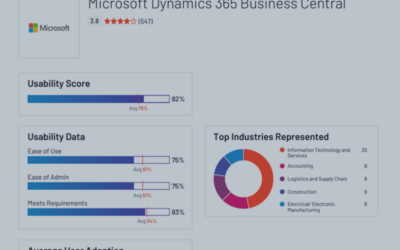The ERP market can seem crowded at first glance and many offerings can seem undistinguishable from one another. It’s important for business managers to take note of the most important key features an ERP should have. You’ll find that most ERPs are sold as pre-packaged solutions with a basic set of features. Some of these give you the ability to buy additional features on top of the basics and this is it where it can get tricky. Optimally, you’ll want to find an ERP that doesn’t require a large investment in add-on features to cover all your business needs. While every company is unique, there are some key features that any ERP should have in their base offering to cover most business’ needs. Here are some important key features to look for in an ERP:
- Modularity
- Scalability and Flexibility
- Mobility
- Integration Tools
- Comprehensive Use
These are five key features every ERP should have. Any ERP software that’s missing one or some of these features should simply not make your shortlist. To give our readers an even better idea of how to look for these key features when shopping around, let’s go into each of them in more depth.
Modularity
Modular design is essential in any modern ERP. You’ll find most best-selling ERPs have modularity in their design. This basically means that the whole system is subdivided into smaller modules that can be used independently. So, applied to an ERP, this means that the software offers a wide variety of modules, but doesn’t necessarily require that you purchase all of them to meet your business needs. For example, let’s say a non-modular ERP offers a CRM, a Sales tool, a Finance tool, a Human Resources tool, Data analytics, Inventory management, and Supply chain management all in their base package. For a manufacturing company, this is perfect as it covers most, if not all their basic business software needs. But for an independent software company, the inventory and supply chain management features are something they are unlikely to use. On the other hand, if an ERP has modular design, it offers all these modules separately and independently. This means that both companies can get exactly what they need without one of them having to pay for additional features they won’t use. A modular ERP also lets a company acquire more modules as their business needs evolve over time. Modularity is a key feature to look for in an ERP.
Mobility
It’s a mobile world today and it will only become more mobile as technology progresses. So, looking for mobility in your ERP is a no-brainer. But many ERP software companies offer mobility as an afterthought; often a mobile app with limited features. You’ll want to make sure your ERP keeps mobility at the forefront of their research and development efforts. The best ERP platforms not only support mobility but deliver usability through their mobile applications. This allows users to access and use their ERP tools at any time, from wherever they are if they have access to an internet connection. Having access to their ERP tools remotely allows information to flow quickly between mobile workers and your company’s software infrastructure. One ERP company that really stands out for its mobility features is Acumatica Cloud ERP. Aside from offering every functionality available on their mobile platform, Acumatica takes advantage of native mobile features to deliver comprehensive functionalities. This means that smart device features like touch screens and voice recognition are exploited to make the mobile platform a more powerful tool. Acumatica’s mobile application feels developed specifically for mobile use rather than adapted to it.
Scalability and Flexibility
When an investment is made in a new ERP system, it’s expected to help a business grow and expand. With growth comes the need for more resources and tools to manage the expanding business accordingly. It is of utmost importance that your ERP can handle scalability and adapt to your company’s growth without having to make a large reinvestment in new software. Some ERPs are great for small-scale operations and start-up projects but may not be able to handle a company that begins to open franchises across state lines, for example. You should look for an ERP that can suit your SMB’s workload now but also has room for growth. The best ERP’s allow you to scale up without causing significant downtime to your operations and without requiring intrusive support from the vendor.
Our first key feature discussed, modularity, is often a good indicator that your ERP will be scalable in comprehensive fashion. But aside from scalability, your ERP should be flexible. Every business is unique in one way or another; it is often the case that a customized solution or feature will be needed to fulfill your company’s demands. A flexible ERP will allow you to customize certain functionalities to meet the specifics your business calls for. A flexible ERP with an Open Cloud Platform, for example, may even let you integrate your previously developed applications into your new ERP system or build them from the ground up. Flexibility and scalability are key features to look for in an ERP.
Integration Tools
Most company’s acquiring a new ERP today are moving away from an on-premise legacy system. The transition from one system to the other can be an ordeal in itself; finding an ERP with comprehensive integration tools and API’s for data integration can make it much easier. One of the main reasons companies often choose to stick with their legacy ERP is because it contains all the customized tools and applications that users depend on daily. The cost of retraining their entire staff to use new tools and applications can be costly and this type of change can often be met with a lot of resistance from users.
But an ERP worth your money will have the necessary integration tools to let you bring over your most important third-party applications, regardless of the platform or development language used. A strong ERP can integrate with third-party databases and software seamlessly, letting your staff keep important tools they’re accustomed to use using. ERPs that have API’s for Data Integration can also help you build customized integration programs, further expanding your ERP’s capabilities. Since your ERP is the central nervous system of your business technology infrastructure, Data integration is an important key feature to look for in an ERP.
Most company’s acquiring a new ERP today are moving away from an on-premise legacy system. The transition from one system to the other can be an ordeal in itself; finding an ERP with comprehensive integration tools and API’s for data integration can make it much easier. One of the main reasons companies often choose to stick with their legacy ERP is because it contains all the customized tools and applications that users depend on daily. The cost of retraining their entire staff to use new tools and applications can be costly and this type of change can often be met with a lot of resistance from users.
But an ERP worth your money will have the necessary integration tools to let you bring over your most important third-party applications, regardless of the platform or development language used. A strong ERP can integrate with third-party databases and software seamlessly, letting your staff keep important tools they’re accustomed to using. ERPs that have API’s for Data Integration can also help you build customized integration programs, further expanding your ERP’s capabilities. Since your ERP is the central nervous system of your business technology infrastructure, Data integration is an important key feature to look for in an ERP.
Comprehensive Use
All the previously explored features are vitally important to make your ERP shortlist. It is equally important to make sure your ERP is user-friendly. The easier it is for your staff to learn how to use the software, the quicker they’ll be able to use it effectively without the need for constant re-training and support. ERP architecture and functionalities work on complex algorithms and design, but the best ERPs manage to project that complexity over simple, intuitive user interfaces. Some ERPs can integrate with open source UX tools, letting companies customize the design and the user experience. An ERP that your staff can learn how to use quickly will make an immediate impact in your workflow. Comprehensive use is a key feature to look for in an ERP.
You can follow us on Twitter and LinkedIn for news and information on ERPs that have all of these key features!




